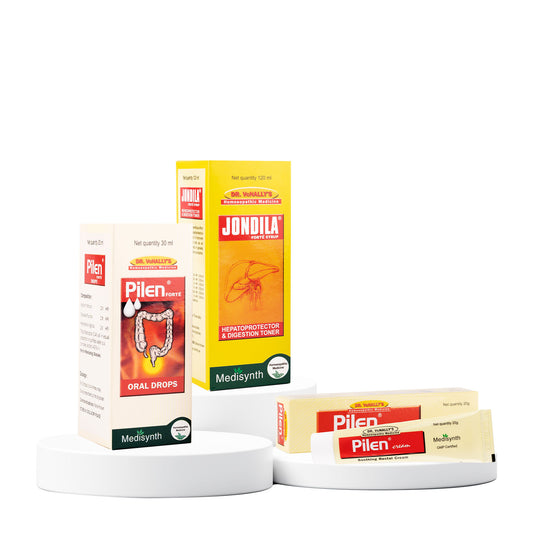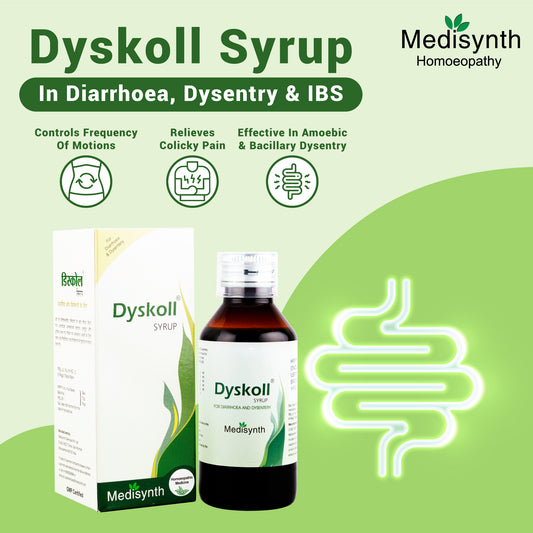Dysentery: Symptoms, Causes, Treatment and Why Cases Rise in Monsoon

Dysentery is not just a common gastrointestinal issue but a widespread public health concern, especially during the monsoon months.
With seasonal changes, especially in tropical and developing regions, the risk of waterborne infections rises sharply, and dysentery is often among the first to surface.
So, what is dysentery? At its core, it's a painful intestinal condition, but the ripple effects can be serious, especially for children, the elderly, and immunocompromised individuals.
This article explores dysentery in depth from how it starts to how it spreads, how it differs from diarrhea, and why monsoon season acts as a catalyst.
What is Dysentery?
Dysentery is an intestinal infection marked by severe inflammation of the colon and frequent passing of stools that contain blood, mucus, or both. It is more than just a digestive inconvenience; it's a signal of a serious infection often caused by contaminated food, water, or poor sanitation.
Unlike general diarrhea, which may involve watery stools but no inflammation, dysentery is a more aggressive condition. The infection directly irritates the colon lining, causing painful cramping, fever, and an urgent need to defecate repeatedly even if the intestines are empty.
The term "dysentery" can be traced back to the Greek words dys (ill or bad) and enteron (intestine), meaning "ill intestine." It has afflicted humans for centuries, especially during wars, famines, and in areas lacking proper sanitation.
What is Dysentery caused by?
When exploring “dysentery is caused by”, one must look at the different organisms that invade the gastrointestinal tract and provoke inflammation.
1. Bacterial Causes (Bacillary Dysentery)
The most common form is due to Shigella bacteria, which are highly infectious and need only a small number of organisms to cause illness. These bacteria are spread through:
-
Ingesting food or water contaminated with feces
-
Person-to-person transmission due to poor hygiene
-
Unwashed hands after using the toilet or before meals
In crowded or unhygienic environments like refugee camps, slums, or poorly managed schools, this form of dysentery can spread rapidly.
2. Parasitic Causes (Amoebic Dysentery)
This form is caused by the parasite Entamoeba histolytica. Once ingested, typically via contaminated water, the parasite settles in the large intestine and causes ulcerations in the intestinal wall. These ulcers are responsible for the blood and mucus found in stools.
Parasitic dysentery often develops more gradually than the bacterial kind, and in some cases, it may become chronic, recurring over weeks or months if untreated.
3. Contributing Environmental Factors
Other contributors that exacerbate the spread include:
-
Improper sewage disposal
-
Flies transferring pathogens from waste to food
-
Consumption of food stored or handled in unsanitary conditions
Symptoms of Dysentery
The symptoms can vary depending on the type of pathogen and the person’s immune response. However, common indicators include:
1. Frequent Loose Stools with Blood or Mucus
This is the most recognizable symptom. The presence of blood indicates ulceration or inflammation in the colon.
2. Abdominal Cramps and Tenesmus
Patients often experience sharp, crampy abdominal pain, especially in the lower abdomen. Tenesmus, a constant feeling of needing to pass stool, even when the bowels are empty, is very common and distressing.
3. Fever and Chills
Since dysentery is an infection, the body reacts with systemic signs like high temperature, chills, and overall fatigue. Fever is more prominent in bacterial dysentery.
4. Nausea and Loss of Appetite
The infection can make eating difficult, and nausea may accompany severe cramping or diarrhea episodes.
5. Dehydration
Due to continuous fluid loss through stool, dehydration can develop quickly, especially in children and older adults. Signs of dehydration include dry mouth, sunken eyes, low urine output, and dizziness.
In some advanced or untreated cases of amoebic dysentery, liver involvement may occur, leading to liver abscesses, which can cause pain in the upper right abdomen, weight loss, and prolonged fever.
Dysentery Synonyms
In casual and medical language alike, dysentery synonyms can vary depending on the cause and region. Commonly used terms include:
-
Bloody diarrhea: Often used in medical reports when describing stool appearance
-
Shigellosis: The medical term for dysentery caused by Shigella bacteria
-
Amoebiasis: Refers to infections caused by Entamoeba histolytica
-
Infectious colitis: A broader term encompassing inflammation of the colon due to various infections
-
Gastrointestinal infection: A generic term that may include dysentery
These synonyms are often used interchangeably, but they carry nuanced meanings depending on the diagnosis and treatment required.
Difference Between Diarrhea and Dysentery
While diarrhea and dysentery both involve frequent bowel movements, they are distinct conditions with different causes, symptoms, and severity.
Diarrhea is typically characterized by the passage of large amounts of watery stool multiple times a day. It often results from viral infections, food intolerances, or a reaction to certain medications or foods.
The condition usually resolves on its own within a few days and is often not accompanied by blood or mucus in the stool. Abdominal pain in diarrhea is usually mild, and fever, if present, tends to be low-grade or absent.
Dysentery, on the other hand, involves inflammation of the intestines, especially the colon. The stools are usually smaller in volume but occur more frequently and are often mixed with blood and mucus.
The pain is more severe and is typically accompanied by cramping, tenesmus (the constant urge to pass stool), and sometimes high fever and chills. Dysentery is usually caused by bacterial or parasitic infections and requires more attentive care and sanitation.
The key differences lie in the severity of symptoms, the appearance of stool, and the underlying cause. Diarrhea may be unpleasant but is generally self-limiting, whereas dysentery can lead to complications if not treated appropriately.
Why Does Dysentery Surge in the Monsoon?
The monsoon season, while refreshing and much-awaited, creates ideal conditions for the spread of dysentery and other gastrointestinal infections. Here's why:
1. Contaminated Drinking Water
Heavy rainfall often floods sewage systems, allowing human waste to mix with drinking water sources. Tap water and even stored water may get contaminated if not properly filtered or boiled.
2. Unhygienic Food Handling
Street vendors or even home kitchens that use unwashed vegetables, stale food, or improperly stored items may unknowingly facilitate the spread of pathogens.
3. Increased Housefly Population
Flies act as mechanical carriers of bacteria and parasites. They transfer germs from garbage dumps or fecal matter onto uncovered food, making it unsafe.
4. Weakened Immune Responses
Frequent temperature changes, damp clothing, and respiratory infections during the monsoon can reduce immunity, making individuals more vulnerable to infections like dysentery.
5. Lack of Sanitation Infrastructure
In many urban slums and rural areas, toilets may overflow or not exist at all. The lack of proper waste disposal leads to fecal contamination in the environment, accelerating the infection cycle.
6. Children Playing in Puddles or Contaminated Water
Children often come into contact with infected puddles, sewage, or mud, making them more susceptible to dysentery when they ingest contaminated material unknowingly.
Natural and Lifestyle-Based Management of Dysentery
While medical treatment is important in moderate-to-severe cases, mild dysentery especially if detected early, can be managed through supportive care and lifestyle measures:
1. Rehydration is Key
Frequent stooling leads to significant fluid and electrolyte loss. Drinking boiled and cooled water mixed with salt and sugar can help. Coconut water and rice water are also beneficial traditional options.
2. Eat Light and Easily Digestible Foods
Avoid dairy, fried, and spicy food. Stick to:
-
Soft rice or rice gruel
-
Steamed apples or bananas (they bind stool)
-
Moong dal without spices
-
Boiled potatoes or carrots
3. Good Hygiene Practices
-
Wash hands with soap after using the toilet and before eating
-
Use clean, disinfected toilets
-
Keep fingernails trimmed and clean
4. Avoid Street Food During Monsoon
Even though monsoon cravings are real, it’s wise to avoid cut fruits, fried snacks, or juices from vendors lacking proper hygiene.
5. Boil or Filter Drinking Water
Use a reliable water filter or boil all drinking water. Adding a pinch of alum and letting the water settle before boiling can help further purify it.
6. Wash Fruits and Vegetables Thoroughly
Use salt water or potassium permanganate solution to clean raw produce.
Conclusion
Understanding what is dysentery and how it differs from diarrhea is the first step to managing and preventing it effectively. With the monsoon acting as a breeding ground for infections due to water contamination and poor sanitation, awareness becomes critical. Simple lifestyle and hygiene changes can make a big difference in the case of prevention of Dysentery.
By focusing on prevention like safe food practices, personal hygiene, and clean drinking water, we can drastically reduce the risk of dysentery outbreaks during the monsoon season. With knowledge comes empowerment, and with preparation, comes protection.
References:
-
10 Nutrition and Lifestyle Recommendations to Manage Diarrhea
- Boericke’s Materia Medica









